Etrian Odyssey (Nintendo DS) Review
By Karn Spydar Lee Bianco  14.07.2008
14.07.2008
It's been out in Japan for nearly a year and a half, out in North America for more than a year, and it's even spawned a sequel that has now launched in the aforementioned territories as well. But, European and Australian gamers have only recently been offered the chance to delve into the labyrinth that is Atlus' first-person dungeon crawling RPG for the Nintendo DS, Etrian Odyssey. Was it worth the wait?
Etrian Odyssey is a turn-based 3D role-playing game with a heavy focus on dungeon-crawling. The game begins by detailing the sudden appearance of a mysterious labyrinth, known as the Yggdrasil Labyrinth, near the outskirts of a small town named Etria. Fuelled by the promise of riches and prestige, a stream of adventurers from across the globe take it upon themselves to enter the Labyrinth in an attempt to uncover its mysteries. As far as plot goes, that's about all there is to it. Although it might seem like a cop-out, EO's director, Kazuya Niinou, suggests that a game becomes far more enjoyable when the player uses his imagination (as a tool to create dynamic and fun situations). As such, you won't find any lengthy cut-scenes or extended dialogue between characters in this game, but rather a blank template upon which you can imbue your own personal creations. It's just one element of Etrian Odyssey that serves as a throwback to the role-playing games (electronic and otherwise) of yesteryear.
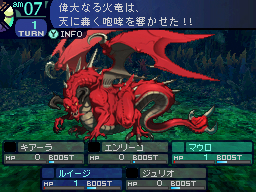
Another such element is map-making. Some of you reading these words will undoubtedly remember a time when the use of a map to navigate in-game locations was not a right, but something you had to work for. If a game didn't include built-in mapping functionality you had to draw your own using good ol' pen and paper. Etrian Odyssey takes this practice - which some will find to be rewarding and therapeutic, and others will simply see as archaic and unnecessary - and updates it for a modern generation of gamers. Specifically, EO utilises the DS' touch screen and allows players to draw their own map of the Labyrinth as they progress further and further into its depths. While it's possible to enable an auto-mapping feature which keeps track of every step the player takes, everything else - including walls, stairwells, and other objects - must be added manually. Doing so is, surprisingly, one of the game's best hooks and helps to provide a true sense of discovery that most games simply can't match. It also helps that the mapping interface is extremely intuitive, allowing the player to make adjustments at almost any time, including during battles.
On the subject of segues battles, you'll be facing off against a wide selection of unfriendly critters in Etrian Odyssey, and they're not your usual cannon fodder either. In case we haven't already made it clear - we haven't, we're just checking to see if you're paying attention - Etrian Odyssey is one tough cookie. Right from your very first mission (which challenges players to map the first floor of the game) death is not so much a possibility as it is an inevitability. Even the game's most basic opponents are more than capable of wiping out your entire party in no time at all. So, what's an adventurer to do? Why, start thinking strategically, of course! When a single wrong-action can quickly escalate into the premature end of a battle, making efficient use of EO's turn-based gameplay is absolutely essential. Knowing your enemy is just as important as sufficiently impressive attributes/equipment, as is knowing your limits. Failing and learning from your mistakes is what EO is all about, but given that the death of all party members results in the loss of any non-saved data, you'll want to be constantly evaluating whether it's in your best interests to press on, or cash-in and return to town (one of the few places you can save and rest at will).
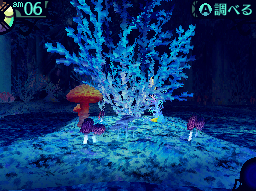
The journey between Etria and the Labyrinth itself is an extremely common one, and, although it's possible to purchase 'Warp Wires' which make returning to town far easier (instantaneous, in fact), back-tracking through levels can become tedious. The problem is somewhat nullified by warp points which appear every six levels or so, but even they may not be enough to prevent players from growing frustrated. It's a situation that isn't helped by a distinct lack of in-game landmarks. While the 3D environments look great, any objects/points of interest in each level are simply denoted by static text, rather than a visual. It's all very Dungeons and Dragons. As an example, many levels feature hidden passageways which can help cut down on travel time, but these look exactly the same as regular walls/trees. The only way to discover them is by standing next to, and facing them, at which point a text-box appears explaining what your character can see, even if you can't. It's a system that has a definite charm to it, and one that melds well with the aforementioned throwback to early RPGs, but it's bound to be off-putting for a lot of players and could have been rectified without compromising the game's appeal.
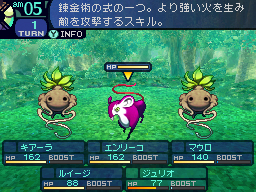
Despite these potential irritations, Etrian Odyssey ultimately thrives as a dungeon crawler thanks to its wonderful character customisation options and combat system. The latter is a simple Final Fantasy-esque, attack-magic-item-flee set-up with a couple of extra features. First is the complete lack of battle animations. Initiating a standard attack, for example, simply results in a brief special effect that causes the recipient to vibrate slightly. It may not sound particularly exciting, because it's not, but it does allow for fast-paced battles that let players focus on what really matters: choosing moves carefully. As far as customisation goes, EO allows players to assign skill points to new or existing skills as and when they become available. With only one skill point available upon each level-up, and a level cap of 70, choosing how to allot points is extremely important in determining the focus of each character. Parties consist of five characters, each of which can belong to one of nine classes, and must be arranged into a particular formation before entering battles. Formations break down into two lines: front and back. The former offering more powerful physical attacks at the cost of an increased chance of being attacked, and the latter allowing long-range attackers and magic-users, etc., to stay out of direct contact while still playing a vital role in battles.
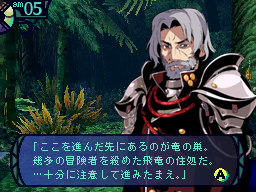
Cubed3 Rating
Great - Silver Award

Etrian Odyssey is very much a love or hate affair. If you enjoyed the classic role-playing games of yore you'll probably going to love EO and its simple-yet-addictive battle system, extensive character customisation, and charming map-making features. If, on the other hand, the idea of extreme difficulty, limited save points, a mostly absent plot, slow pacing, and the possibility of losing whole session's worth of progress sounds more like torture than an enjoyable gaming romp, you might want to steer clear.
Comments
Comments are currently disabled

 Sign In
Sign In Game Details
Game Details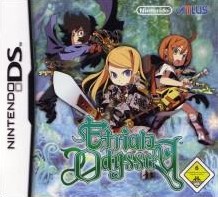
 Out now
Out now  Out now
Out now  Out now
Out now  Out now
Out now  Subscribe to this topic
Subscribe to this topic Features
Features





 Top
Top

